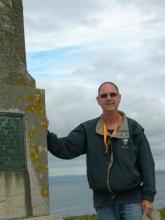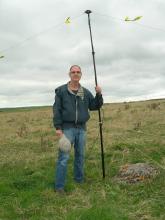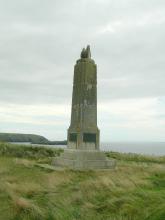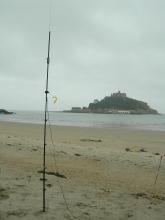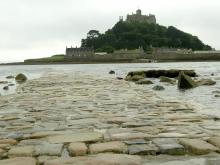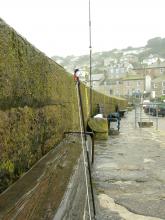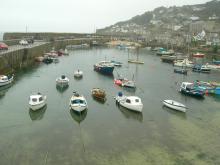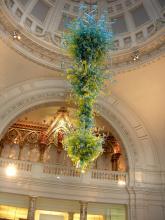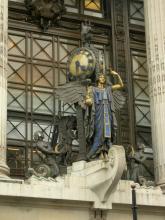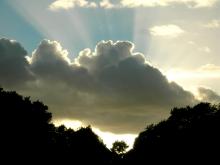Ralph in England
Ralph in England
Many Amateurs who work on the HF bands have the opportunity of contacting many stations from across the world and have an enjoyable time doing so. With improved antennas and radios, it is becoming relatively easy to ‘work the world’ as the saying goes. What most Amateurs don’t have, is the opportunity to go to some of these countries and operate from there. In years past, one county did not necessarily recognize the qualifications of another, and Amateurs wishing to operate in other countries would have to get certification from the country in question, generally at some time and expense of the individual Amateur.
Today, however, with the ‘shrinking’ of the world in terms of time necessary to travel to foreign soil, and the ease that Amateurs certified in one country could gain permission to operate in others, the opportunity afforded to Amateurs travelling in foreign countries to get on the air is increasingly easy.
I had just such an opportunity recently, when I decided to take a two week vacation in England and visit Cornwall, a county in the south west corner of that country, and one which played a very important role in the radio history of the world. In order to operate there, I had to apply for a permit to operate, rather than obtain a licence from the regulatory authority in Great Britain. As the UK is a member of the European Union and signatory of the Conférence européenne des administrations des postes at des télécommunications (CEPT), I was able to obtain that permission from the Radio Amateurs of Canada (RAC) in Ottawa. That permit, along with a copy of my Canadian licence (I used my wallet cart) allowed me to operate legally anywhere in the world in countries who had signed CEPT recommendation T/R 61-01 (that allowing foreign Amateurs to operate). I would use the callsign G/VE7OM/P during my time in England, and was looking forward to the experience.
For a number of weeks prior to my departure I agonized over what equipment to take and how I would get it into the bags that I would be taking. As I anticipated doing a bit of hiking with the gear to get to some interesting operating venues, it had to be light. Luckily, I owned an Elecraft™ KX1, a very light transceiver that operated at only 4 watts and consequently didn’t take a big battery to power, and it operated on a number of bands that I wished to operate on, namely 40, 30 and 20 meters. I had a portable antenna made by Buddipole™ that I was able to use in conjunction with wires to form an inverted vee or a vertical with a wire counterpoise. Wanting to keep the weight down, I decided not to take the tripod that was in the Buddipole™ kit, but to use the mast by itself and three cords as guys instead. I had considered going with a random wire configuration that is suggested in the KX1 manual, but I had been counceled that a resonant wire will ‘want’ to work, so I went with the dipole and vertical that I had experimented with and measured the resonant frequencies of, so I was sure that as it would ‘want’ to work, I would have better luck with that than the random wire. That, and an A123 battery pack to provide 13.5VDC to power the radio, and I was all set. Luckily, it all went into a roller bag and left a bit or room for essentials like cloths, toiletries and the like!
I left for England on September 3rd, and arrived around noon on the 4th. I arrived just as the strong high pressure over England was subsiding, but even so, it was about 25°C and lovely and clear.
I decided on my first day there, I would visit the Royal Artillery museum at Woolwich Arsenal and do some other touring. As the day was warm, I was able to sit outside, sample some of the local ales at a pub, and enjoy being there. On the way there, I stopped off in the east end of London, at Shadwell, and visited a church there that I had heard about. This church had been home to some of the many sea Captains of its heyday and many are buried there in the churchyard. When I got back into central London, I decided to check out a large park that I had seen from the underground station that I had departed from, as it seemed like possibly a good place to try to operate the radio from. This park turned out to be Kensington Park, and indeed was good for radio. Unfortunately, I couldn’t set up just then, it would be too late, but I decided that when I returned from a brief visit to Birmingham, I would give it a try.
Upon my return to London from Birmingham, in the evening of Sep 8th, I took my radio equipment to Kensington Park, found a bit of flat space, and set up the antenna and radio. I had learned that parts of many of the parks in England are kept ‘rough’, that is not mowed or tended. These natural grasses and other plats allowed the indigenous insects and small animals to have a natural home. These open areas also allowed the ground to be a bit softer than mowed grass so I was able to get my tent pegs and other things into the ground to support the antenna that I had. in any case, the KX1 has a tuner built into it, so the dimensions of the wires that I had found to work at home, were adequate here, the tuner worked out the differences, and I was able to make two contacts on CW from that park. I operated on 40 meters, as I thought that being in the evening, that band would be fairly open. Was I surprised; it was just crawling with signals. I hardly could find a clear spot in which to call CQ. I had been encouraged to use the QRP frequency 7.030 as a base, and that frequency, plus or minus about five was lousy with signals. I heard a number of stations there, calling CQ, answered a few but to no avail. Finally, I was able to make contact with a German station, and had a 20 minute QSO with him, followed about ten minutes later by an English station, and was able to have a nice short chat. I was fairly late in setting up, so I decided to cut things short, resulting in having to pack things up in the dark, and indeed it was dark! I was surprised at how radio quiet it was there. I could hear the sounds of the traffic moving along the roads nearby, a concert was being held in Hyde Park adjacent to Kensington Park, and of course these parks are central London, one of the largest and most heavily industrialized cities in the world. It didn’t seem to make any difference; the band was QRM free, allowing me to hear most of the signals available to my location.
The next time I was able to operate was from Penzance, Cornwall...this on the evening of Sep 10th. Penzance, made famous by the operetta duo of Gilbert and Sullivan in their production of ‘THE PIRATES OF PENZANCE’ is one of the larger towns along the south west coast of England, just east of Lands End and is bounded by Mount Bay, which has St. Micheal’s Mount, an island that is connected by a land bridge at low tide. The evening I arrived in Penzance, it was early, and the weather fairly clear, I walked over to Penlee Park, a large green space near where I was staying, and found a bench in which to sit down. The ground sloped gently to the South, so my signal would find its way across the English Channel and into continental Europe. I set up the inverted vee on 40 and was able to make a contact with a French station followed by a Scottish one. Both times, good signal reports both ways, and considering I was only using a QRP radio running about 4 watts, and a vee that had its apex 8 feet off the ground, I think it did a very respectable job.
The next morning, Sep 11th, I set off for Poldhu, Cornwall. There is no ‘place’ called Poldhu, but there is a bay and a series of bluffs that go by that name. I bought a day pass bus ticket and started on my journey. Poldhu is the place where Marconi set up his transmitting antennas and transmitter that succeeded in sending the Morse ‘S’ that was heard in St. John’s Nfld in December of 1901. The field where he established his antenna farm faced the sea directly to the west, the direction to North America that he wanted to be heard. I arrived on a windy (it’s always windy by the sea in Cornwall) cloudy day, threatening rain. I got off the bus at Poldhu Cove and walked up the road towards a building that used to be a hotel, but now a care home. There is little marking the site as to what significance it holds, except a few small signs indicating the path to the Marconi site and center. I walked into the field, after opening the latched gate and went to the marker on the Cornwall Coast Path which indicates that place as where Marconi conducted his radio experiments. I could walk over to the foundations of the transmitting hut and see the massive cement guy wire footings in a great circle around what would have been the antenna support masts.
I set up my dipole near the cliff edge on 20 meters and radio near the path in the field and used one of the antenna mast guy wire footings as a seat and tuned across the band. I was able to work a number of stations including my first trans-Atlantic QSO with a station in South Carolina. Again, the band seemed quite busy, and the contacts were fairly short—typical 20 meter handshake style but with a bit of ‘back and forth’ as well. One of the French stations that I worked commented on the Poldhu QTH that I had given and asked about the Marconi significance. I was quite happy to be able to tell him that I was in the field that he had used for his antenna farm! As it was quite windy, my fingers had to be warmed up from time to time, but to visit the site where long distance radio really began, gave me a warm feeling that I’m sure I will feel throughout my Amateur life. Just after 13Z, I had to call it quits, as I wanted to get back to Penzance, and didn’t know how often the busses operated. On the way out of the field, I stopped in at the station GB2GM, the commemorative Amateur station operated by the Poldhu Amateur Radio Club which was open by now, and contained, in addition to three operating positions, an interpretive center for the Marconi radio experiments.
On my return to Penzance, I made a short side trip to St. Ives, on the north coast of the county, but did not operate from there.
The following day, Sep 12th, again it was very weather threatening, so I decided to take the bus down to St. Micheal’s Mount, an island just off the coast in Mounts Bay and is accessible by a land bridge at low tide. Small boats ferry tourists to the island when the tide is high, and the land bridge unavailable. When I got to Marazion, the small town opposite the mount, the weather was light rain showers, but would clear off now and then and the tide was high, so I could not access the island by the land bridge. I decided to set up the radio and antenna on the beach opposite the island and see what I would be able to do. As I was right beside the salt water, I set up the Buddipole™ as a 20m vertical, using a wire counterpoise. I had spent time practicing setting the antenna up as a vertical, and had used this configuration many times, so setting it up was no problem. I was able to get on the air, sitting on the rocky berm and was able to make contact with two US east coast stations, both in North Carolina. As it was quite windy and rainy, I cut my operating short, shutting down at 1200z, and made my way to the land bridge to the island which was just beginning to show at the beach end.
I would have liked to operate from St. Micheal’s Mount itself, but there just wasn’t the public place for me to operate. I could have gone onto the private grounds of the castle, and its gardens, but it just didn’t work out this time. Perhaps one day if I go over when the weather happens to be better...oh well!
The next day, Sep 13th, dawned somewhat brighter than the one before, but still very cloudy, but not much wind. I walked up to the town, and bought some lunch which I put into my backpack for later. I walked down to the seaside and walked along the promenade toward the west and the Cornwall coast path. This path allows walkers to hike along the coast of Cornwall (and other counties the border the sea) and passes through the many small fishing villages and other places that are on the seaside. I intended to walk west towards the small fishing village of Mousehole (pronounced Mouz’l) about four miles along the path. I set out and by the time I got into the next town, Newlyn, it was showering off and on. I managed to get to Mousehole and decided that since I had gone the distance, I would set up the radio at some place near the ocean. The best place I could find was the harbour breakwater that stretched out into the sea. It was raining off and on when I set up, so I didn’t want to spend a lot of time thinking about how I was going to get the antenna up in the air. I succeeded in getting the antenna mast supported by an interference fit on one side by the stone wall, and the other by a square wooden timber that was used as a bench. I supported the counterpoise with some of the light twine I used when I supported the mast with guys, and got on the air. It was nice and radio quiet and was able to contact four stations in continental Europe on 20m during the hour that I set up. After shutting down, I enjoyed a warm cup of tea and a Cornish pastie, then walked back toward Penzance and a hot shower.
The next day, Saturday, Sep 14th was to be my last day in Cornwall. It was bright and clear with sunshine and bright blue skies. I should have used that day to do my walking, but nonetheless, I decided to take it easy, do some walking around the town, and set up the radio again in Penlee Park. I decided this time to try 30 meters, as I had been told that it was a very good band ‘over there’, and I had not tried it yet. I got to ‘my’ bench and set up the mast and inverted vee. As I mentioned before, I had measured the lengths of wire to use for these antennas before I left home, so all I had to do was find my bit of marking tape on the wire and that was it. Again, the KX1 found a match and I tuned around the band. Thankfully, again, it was quiet, with no QRM to worry about, and I was able to make a number of contacts in continental Europe during the hour or so that I had the radio set up. I had a number of visitors to my location during the nice day, including a gentleman who was a SWL and CB radio operator. I explained what I was doing and the portable nature of it...he seemed quite impressed, at least he seemed to understand what it was all about. I had thought about setting up on 20 meters later in the afternoon, but that didn’t happen.
The next day, the Sunday, I packed all my gear and walked the 15 minutes across town to catch the National Express bus to London. It wasn’t crowded until I reached Plymouth as it acts sort of like a local bus in the far west, but after that it filled up and took the motorways from there to London, arriving more or less on time at the Victoria Coach Station.
On Monday, Sep 16th, again it was bright and clear. I walked across Kensington Park to the Albert Memorial and Royal Albert Hall, then through some of the streets to the Victoria and Albert Museum and the Museum of Natural History. I waited about half an hour for the museums to open then spent a couple of pleasant hours walking through their collection of historical artifacts. It is quite something to walk among ancient statues, some I’ve only heard about or seen pictures of. Here was the ‘real thing’!
After a couple of hours, I decided that I needed to get going, as one cannot possibly give these museums a good walk through in one ‘sitting’. They have to be done slowly over a number of days and visits. I left the V&A and walked up Brompton Road, passing Harrods and a number of upscale clothing shops, I probably couldn’t afford to breath the air in them, then through Hyde Park and onto Oxford Street and into Selfridges. I was able to make a small purchase there (chocolates for my wife) and then walked back up Edgeware Road towards Paddington and my hotel.
Later that afternoon, as the sun was shining, although some clouds were threatening, I decided that this would be the last opportunity I would have to set up the radio. I collected my gear and walked back to my spot in Kensington Park, this time, setting up so I could sit under a shelter in case it did rain. I’m glad I did, as there were some somewhat heavy showers that came by. I set up again on 40m and made five contacts in continental Europe but one in England, an Amateur who was a radio dealer who was using an Elecraft™ KX3. I operated for about an hour as the weather was continuing to threaten and I had to get my things ready as I was going down to Surrey the following day and wanted to get my things ready for my trip home on the Wednesday.
That marked the last time I was able to set up and operate in England. All in all, it was a glorious experience, and one that I would recommend to anyone with the gear and the wherewithal to `brave the elements`, so to speak and operate a QRP radio with a limited antenna. Not only does it give you the `feel’ of operating from a foreign country, it allows us to contact stations that we might not normally be able to contact from home. Many countries have a `novice` level that might not allow their users to have as much power at their disposal as the regularly licence Amateurs. By `being there`, we can expose them to some `DX` as it were, and the thrill of working someone from afar, even though they are operating nearby.
There may have been better, perhaps more efficient antennas that I could have used, and likely a higher powered radio, but as my son always says....it is what it is...and that is what I used. I went with what I had, and set up where I could, and operated when I found the time. Definitely, if I were with others, I would not have been able to operate as much as and where I did, as I would have had some responsibilities to them. Being on the trip alone, allowed me to make my own schedule, walk to where I wanted, and stay as long as I liked.
I would encourage any reader to give this sort of operating a try. You don`t have to go where I did, but even some local park, peak, or seaside will do.
Ralph Webb, VE7OM
September, 2013

